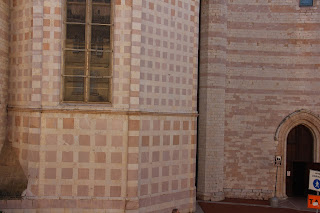On our last day in Perugia we were tossing up between visiting an Etruscan tomb or heading back to Assisi to finish our tour of St Francis's town that we had cut short after we got hit by a squall the afternoon we were there. Assisi won, and though this is now our third time there over the years we still find so much that is interesting. It is a light pink and white stone, too, which makes it very light, very pretty. Almost all of it. And, today, it seemed to glow for us in the bright sun.
Water still pours from springs ducted by the Romans to bring fresh water to the city some 2,000 odd years ago. Clusters of carved olive wood sticks on the steps of one house point up the occupation of one of the locals even today.
We wandered downhill through medieval lanes and remnants of the elliptical Roman amphitheatre now bordered with homes for locals, stone upon stone, until we came to the Cathedral of San Rufino.
A rather gruesome stone sculpture at the church entrance is a reminder of those tough Roman times when Paganism and Christianity were vying for supremacy. Here, a lion is depicted eating a Christian martyr. Knowing this might be their outcome these amazing early Christian still believed.
San Rufino was martyred here in the third century for converting to Christianity, and interestingly, is Assisi's patron saint.
Further down the hill in the pagan Temple of Minerva which was later reconstructed as the Church of Santa Maria supra Minerva the original temple stone floors at the sides of the Christian altar, still bear the original holes used for drains when any blood sacrifices were made here.
Francis, and Clare, are two of the most famous saints in all of Italy. Hoards of people each year are here primarily to visit this town, this church, and to remember the lives of these two locals.
Inside San Rufino church is the actual font where Francis was held over the waters and baptised into the church by the local priest, in 1181. San Rufino was Francis's local church. Here he attended every time he went to mass. He lived just a few steps away and walked these streets most days of his short life. Just down the hill and across the valley you can see the church where he worked and where he died.
When he was just thirteen, a young Assisi girl, Clare, was baptised over the same font. When she was eighteen she happened upon the local boy, Francis, speaking eloquently of his beliefs from the pulpit of this very church. It impacted her so completely that she left her family, as did he, and became one of his most ardent followers in the little stone church down in the valley, where this daughter of a noble lived out forty more years as a barefoot vegetarian, living a most secluded life given over to prayer, abstinence and hard manual work.
Together, they achieved the impossible. Their simple, devoted lives became a sharp lesson in humility to a very out-of-touch religion on how to appeal to the common man.
Relics of their selfless lives survive to this day. Her tomb is just a few steps down the hill in a special church built by her order and dedicated to her, the Basilica of St Clare : a wax effigy lies in state above her remains. A snippet of her hair is kept in a silver box. The white tunic that she wore she stitched herself by hand. The simple ragged clothes and soft shoes are remnants belonging to Francis.
The wooden crucifix that Francis knelt before in the valley church when he was terribly torn between his beliefs or his family wishes, seeking guidance, has now been hung here. Kneeling in front of this cross he heard the call to rebuild the church, then set about doing that literally and metaphorically: changing it forever.
Assisi is one of our favourite towns in all of Italy.
 |
| Assisi on the hill |
 |
| Excellent craftsmanship in the brickwork |
 |
| Under the arch |
 |
| Fresh water springs ducted by the Romans some 2000 years ago |
 |
| Carved olive wood sticks used even today |
 |
| Homes are now built around the elliptical curve of the old Roman amphitheatre |
 |
| Cathedral built to contain the relics of Bishop San Rufino |
 |
| San Rufino martyred for converting to Christianity is Assisi's patron saint |
 |
| Gruesome sculpture of lion eating a Christian martyr |
 |
| Pagan temple floor had holes used as drains for blood sacrifices |
 |
| The actual font where Francis and Clare were baptised thirteen years apart |
 |
| White tunic stitched and worn by St Clare |
 |
| Ragged simple clothes of St Francis |
 |
| Kneeling before this cross Francis heard the call to rebuild the church |














No comments:
Post a Comment